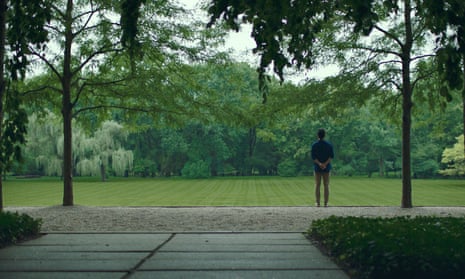The architecture is the star of this absorbing and intelligent debut feature from the Korean-American film critic and film-maker who works under the pseudonym Kogonada. In this quietly beguiling piece of work, he dares to do something beyond the reach or interest of many film-makers, and that’s simply to be different. Columbus is an engrossing and unexpectedly passionate film, although much of the passion is displaced outwards into a feeling for space, for mass, for building materials. It is a static passion, but not inert. I liked the film very much, although there are some self-consciously opaque contrivances about which I am unsure.
The setting is the midwestern US town of Columbus, Indiana which happens to be a mecca for architecture fans and scholars because of a remarkable concentration of modernist work, including Eero Saarinen’s Irwin Union Bank and Myron Goldsmith’s Republic newspaper building. The various fascinating interiors and facades are explored in gorgeously unhurried, spacious shots that evoke Kubrick – a critical interest of Kogonada’s and an obvious influence here. (I wonder also if he took something from Jim Jarmusch’s movie Paterson.)
Haley Lu Richardson is outstanding as Casey, a young high school graduate and fledgling architecture buff who loves her local celebrated buildings but can’t go off to college because she feels she has to look after her mother, a recovering drug addict. Quite fortuitously, she encounters Jin (John Cho), a man in early middle age who has come to Columbus because his father, a famous South Korean architect in town to deliver a prestigious lecture, has collapsed with a stroke and is in a serious condition in hospital. Like Casey, Jin has painful, complex emotions connected with family and loyalty. It is his duty to be at his father’s bedside up to the moment of what will very probably be his death in this strange land. But the two men are estranged, and Jin also has difficult unresolved feelings for his father’s companion or amanuensis, Eleanor (Parker Posey is excellent in this role), who is also by his side. Smart, ingenuous, emotionally generous Casey strikes up a friendship with Jin, and Cho shows how his character is tensely aware of how and where it might develop, and is uneasily aware of how she seems like a younger version of Eleanor.
Architecture is not merely the backdrop or the bonding premise for their friendship. Notions of visibility and accessibility are vital. The wide panes of glass and low-level floors of a certain building allow Casey to make a crucial discovery about her mother. It is a very engaging film, though I was not entirely convinced by scenes in which Kogonada puts moments of dialogue behind glass, so you can’t hear what is said. Of course, the occlusion is deliberate – an expression of mystery and interiority – but I found it a little affected. Yet this is a challengingly intelligent film, and Richardson is just superb.
